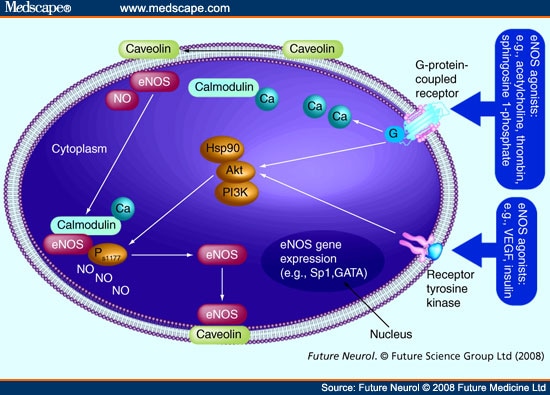Impact of Endothelial NOS-derived NO on Cerebral Ischemia
Endothelial NOS-derived NO may contribute to different pathways related to the pathophysiology of ischemic stroke. This review focuses on CBF regulation, thrombotic processes, inflammation and angiogenesis, as well as neurogenesis.
Several mechanisms regulate NO release by eNOS. Transcriptional and eNOS promotor activity depend on special binding sites, such as Sp1 and GATA.[20] Regulation of eNOS-mRNA stability and post-translational modification of the eNOS protein, for instance by Hsp90, have been described.[21,22] Furthermore, different cellular localization of eNOS in the plasma membrane, plasmalemmal caveolae and the Golgi apparatus shows functionally active enzyme.[23] In addition, factors such as fluid shear stress, ingredients of red wine, estrogen, VEGF and others are able to activate eNOS through direct phosphorylation by either Akt-dependent or -independent mechanisms (Figure 1).[24,25,26,27,28]
Mechanisms regulating nitric oxide release from endothelial nitric oxide synthase.
eNOS is regulated by changes in intracellular calcium and by direct phosphorylation.[18] Transcriptional and eNOS promotor activity depends on special binding sites, such as Sp1 and GATA.[20] Regulation of eNOS-mRNA stability and post-translational modification of eNOS protein, for instance by Hsp90, have been described.[21,22] In addition, factors such as fluid shear stress, ingredients of red wine, estrogen, VEGF and others are able to activate eNOS through direct phosphorylation by either Akt-dependent or -independent mechanisms.[24,25,26,27,28]
eNOS = Endothelial nitric oxide synthase; NO = Nitric oxide.
Augmentation of eNOS is usually associated with increased enzyme activity and NO release. Under pathological conditions upregulation of eNOS may also result in a reduction of bioactive NO. Bioavailability of NO may decrease through its interaction with vascular superoxide derived from NAD(P)H-dependent oxidases.[29] In addition, after eNOS uncoupling - a condition where eNOS is deprived of essential cofactors such as tetrahydrobiopterin - superoxide rather than NO is produced.[30,31] eNOS uncoupling was shown to play a role in endothelial dysfunction owing to diminished bioavailability of NO.[32]
Endothelial NOS expression was found to increase soon after ischemic damage. Therefore, the benefit versus harm of eNOS induction on stroke pathology is a subject of controversy.[33] Generally, infusion of the eNOS substrate L-arginine during ischemia was shown to be neuroprotective.[34] Furthermore, different treatment paradigms such as HMG-CoA-reductase inhibitors (statins), angiotensin (AT1) receptor antagonists and calcium-channel blockers all enhance eNOS expression and/or activity, which may positively impact on cardiovascular diseases by reducing endothelial dysfunction and supporting regional blood flow.[35,36,37]
Studies on the effects of eNOS polymorphisms on cardiovascular risk have yielded conflicting results. Especially for cerebral ischemia, data seem to be inconsistent. There is evidence for an increased stroke incidence in patients homozygous for the eNOS polymorphism on exon 7 (G894T).[38] By contrast, no association between ischemic stroke volume and the G894T polymorphism was found.[39] Future studies using the genetic approach as a translational model are needed to further characterize the role of eNOS in cerebral ischemia in humans.
Future Neurology. 2008;3(5):537-550. © 2008 Future Medicine Ltd.
No writing assistance was utilized in the production of this manuscript.
Cite this: eNOS And Stroke: Prevention, Treatment And Recovery - Medscape - Sep 01, 2008.











Comments